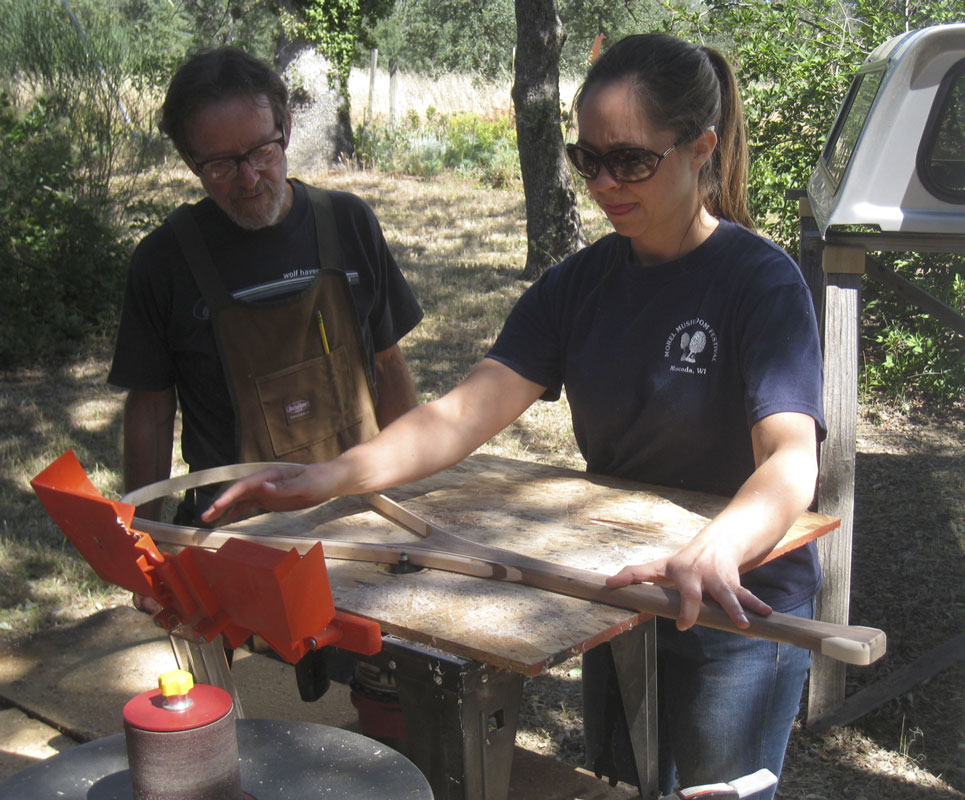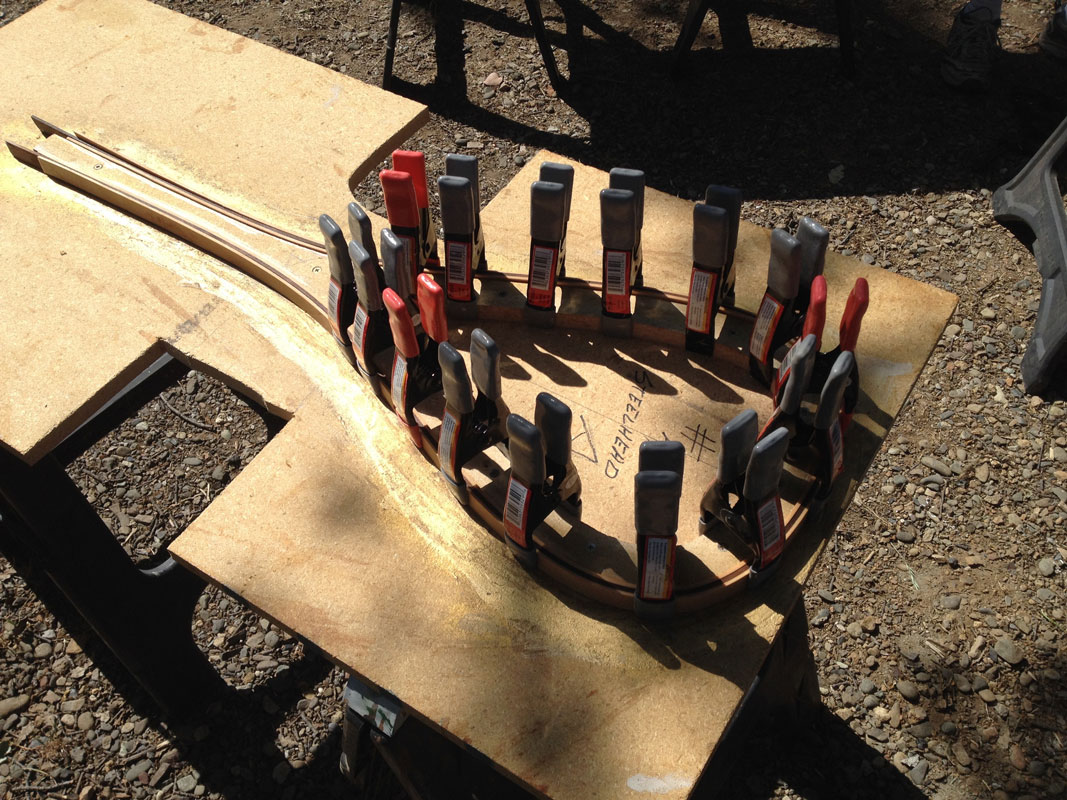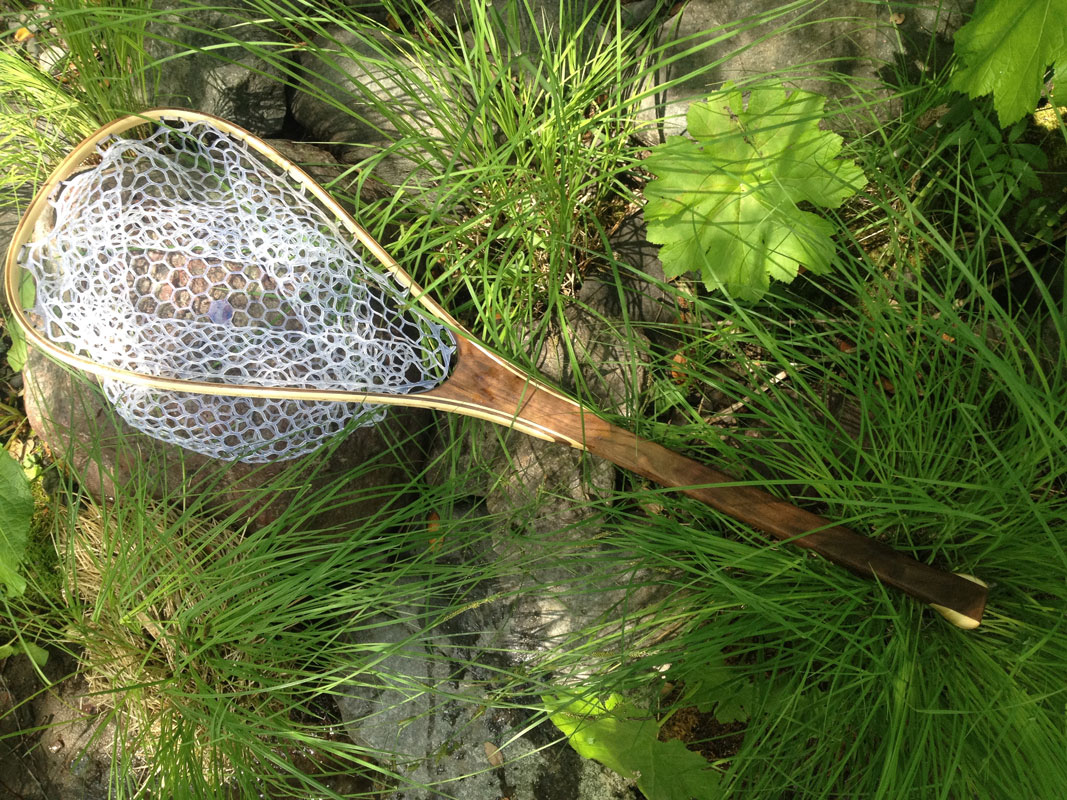A cloud of fine dust billowed up behind my Subie, leaving a hazy trail behind me as I bounced down the dirt road leading to Tom’s house. From his neighbor’s yard, a longhorn steer threw me a half-interested glance as I pulled up the drive. It was a bright morning in May, and I was on my way to build a landing net with the Shasta Trinity Fly Fishers, my local fly fishing club.
I was a little nervous; partly because the club is comprised mostly of retirement-age men (and I’m a 30-something woman), but mainly because I had no experience with woodworking. As I approached the shop, which was chock-full of unfamiliar machines, wood scraps, and sawdust, I was greeted by that quizzical but benign look I often get while rowing a drift boat down the Lower Sacramento, my home river. That squinty-eyed, head cocked to the side, mouth open just a little look. Most often, as it did today, that look gives way to a bemused grin as the looker works through his surprise, confusion, and ultimately excitement at the strange sight of a woman fishing, rowing, or like this morning, arriving to build a wooden steelheading net from scratch. To his credit, Tom - the picture of a grizzled Northern California trout bum in cutoffs and Chacos - offered me a warm welcome and introduced me to my fellow net builders: Alan, Don, and the other Don.

Before that morning, my experience with tools was limited to hanging pictures at home, and wrestling Ikea particle board into the rough semblance of a bookcase by sheer force of will and unbridled cursing. Needless to say, I had no idea what I was doing. I decided not to highlight that fact, instead jumping right in alongside Tom, Alan and the Dons. I selected walnut and maple, because the maple’s light honey grain contrasted beautifully with the walnut’s rich coffee tones. We started by measuring and cutting the handle—at this point just a square-edged stick—and then used wood glue to attach more bits of wood that I was assured would later become a base for the hoop.

Suddenly, without adequate (for me) warning, it was time to use those mysterious machines I’d been eying all morning. I was directed to use the bandsaw to shape the blocks we’d attached to the net handle. Perhaps sensing my hesitation, Tom gently asked “Do you know how to use this kind?” Graciously intimating that perhaps I was more familiar with a different model. In the interest of safety, I decided to come clean. “Uh, well, no … actually I’ve never used any of this stuff before. Maybe I should’ve mentioned that earlier,” I replied. He seemed unconcerned, so after a brief (and some might say, overly-trusting) tutorial on the procedure, I feigned confidence and began sawing. In truth, I was pretty sure that one of the Dons would soon be driving me to the nearest emergency room to reattach a finger. Somehow, despite my pounding pulse and inner monologue (“Why are they letting me do this!?”) I made it through, digits intact.

Next, we took three long ultra-thin strips of wood that had been soaking in water overnight, and bent the pliable pieces around a premade, net-shaped form. We sandwiched the strips together with wood glue, globbing on what seemed like gallons of the stuff. Then we secured the strips to the form with clamps, the rubber-tipped claws spaced so tightly together they nearly touched. Glue oozed from between the strips, gumming up our fingers and the wet rags we wiped over the surface in a vain attempt to keep the mess contained. All that glue and all those clamps sure seemed like overkill to me, but who was I to question the process? I just shrugged and figured it would work out. Besides, I was pretty happy with my progress. After only a few hours of work, the net was really taking shape. I headed home for the day with a little bounce in my step, excited to add “bandsawing” to my resume of life experiences.

The next morning, I arrived at Tom’s shop 10 minutes before the appointed 9AM start time, but I felt like I was already late. I should have known this group of fishermen would be early birds. I was still nursing my coffee while they were just about ready to break for lunch. But first, we had to remove the nets from their forms. As I expected, all that wood glue had done its job and then some - the nets were cemented to their particleboard forms. We had forgotten the crucial step of coating the form with paraffin wax to keep it from sticking to the nets. With intense yet delicate effort, we chipped away at the glue, muttering under our breath, and trying to minimize damage to the fragile hoops. Just a little worse for the wear, they finally came loose.

Finally, it was time to rout the net’s square edges. If the bandsaw was intimidating, the router was downright terrifying. I could tell this machine was serious by the otherwise laid-back Tom’s nervous admonitions, and by the fact that he discreetly hovered over my shoulder as I worked. I furrowed my brow, bit my lip and concentrated like my fingertips depended on it. I probably hold the record for slowest routing job in history, but no blood was spilled, so I count my effort as a victory. My net was instantly transformed, fitting comfortably in my hand with its new softly rounded edges.
The final step in the woodshop was to cut the notch and drill the holes for the net bag. Having mastered the router, I was newly confident in my tool-handling skills and breezed through these simple tasks. With that, I thanked Tom, Alan, and the Dons for their help over the past few days, and they sent me home with a stack of sandpaper. To finish the job, my homework was to hand sand the wood’s still-rough surface. Tom promised this would be meditative work, especially when done in the backyard on a warm spring night, beer in hand. He was right—an icy IPA made the sanding tolerable. I worked away, with ever-finer grit paper, polishing the coarse surface until the wood became silky and smooth. I finished the net with a few coats of Danish oil and the grain glowed: rich, golden and ready for its first fish.
The following weekend, I christened the net at The Church, also known as the McCloud River. This pristine spring-fed trout heaven meanders through a remote canyon in the Southern Cascades, just north of Redding, the town I’m lucky to call home. Scooping up the inaugural rainbow in my handmade net was a thrill. I felt proud of my first attempt at woodworking, and of making inroads into another male-dominated pastime. I realized that, as in most situations in life, pretending that you know what you’re doing is almost as good as actually knowing.
The steelhead-sized hoop was overkill for the McCloud’s resident rainbows, but I don’t think they minded the extra wiggle room in the soft rubber basket. To this day I love my net, but I may have to make another one … my husband keeps stealing it.
